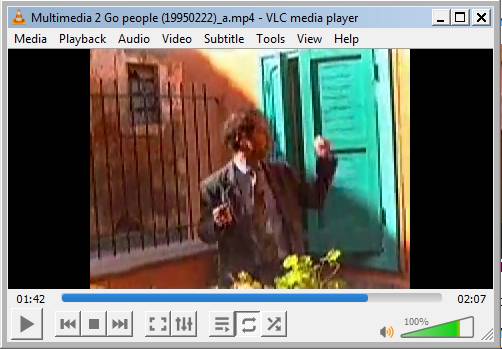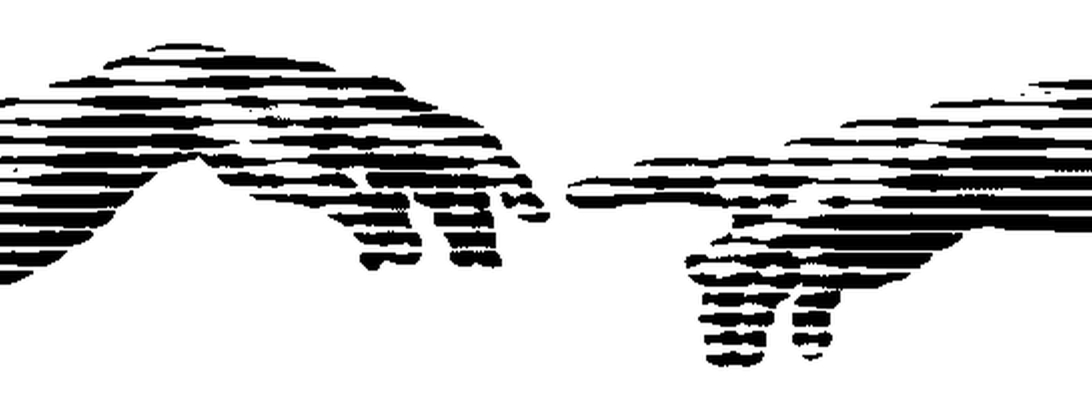l'inizio della compressione video industriale
Nel 1995 entrai in Stream dove divenni responsabile del laboratorio MPEG del Digital Production Studio.
Stream - lo stesso nome era un avventura - era una iniziativa mirabolante di Miro Allione, precedente amministratore
delegato di Stet (nominato da Prodi).
Lo stesso nome della societa' (ora un normale concetto, 25 anni fa un sogno) era futuribile, il logo era
ricavato dalle due mani di Dio e Adamo dal giudizio universale di Michelangelo.
Miro Allione incastro' la Bell Atlantic (oramai solo uno dei telecom operator di New York, dopo lo
spezzatino imposto da Reagan alla Bell) e fregandola sul tempo le impose - contrattualmente - di
attivare il sistema VideoMagic (clone del sistema Stargazer progettato dalla stessa Bell Atlantic), primo
Video Over Dialtone del mondo, prima che negli USA stessi: insomma VideoMagic fu il primo sistema
di Video On Demand (VoD) digitale del mondo, la prima applicazione
commerciale (commercialmente molte attivita' di Stream furono fallimentari) di Video Over Dialtone.
Video Over Dialtone (era anche il titolo del libro di Daniel Minoli
pubblicato da McGraw-Hill nel 1995 con questo nome), perche' per la prima volta si usavano dei doppini
telefonici per la distribuzione mediante ADSL di larga banda (al tempo 1.5 Mbps), circa 500 volte in piu' della
banda nominale del doppino di 3 KHz che mi avevano fatto studiare a scuola
Tra l'altro la rete SIP (che poi divenne Telecom Italia) con una distribuzione capillare sul territorio -
specie in citta' - possedeva una rete particolarmente adatta all'ADSL per la capillare diffusione di nodi di
rete a su tutto il territorio nazionale.
Stargazer-Videomagic prevedeva inizialmente lo streaming di mpeg1 (358x288, un quarto di PAL, CIF) a circa 1.5
Mbps di banda.
Poi al momento della commercializzazione dei servizi via cavo e satellite si uso' l'halfD1, 720x288.
I contenuti erano wrappati in transport stream mpeg2 (esattamente come il contemporaneo DVB), ma non c'era gran
che a parte un elementary stream video a 1200 Kbps ed un elementary stream audio mpeg1 layer2 a 192 Kbps
(sembra una cosa fossile ed incredibile, ma il layer3 era considerato ancora troppo complesso).
Quando ho cominciato ad occuparmi in modo industriale di compressione video MPEG (a quel tempo 1&2)
il problema era riuscire a fare la DCT (Trasformata Discreto-Coseno) molto velocemente, almeno quanto bastava a
trattare tutti i macroblocchi nei quali i singoli field erano suddivisi (circa 160000 al secondo in PAL, che -
con la DCT inversa - corrisponde a doverne calcolare circa 600 mila al secondo).
Per questo si potevano sfruttare dei mainframe/mini (come voleva fare l'IBM e la Digital) oppure dei RISC array
processor: circuiti integrati contenenti matrici di calcolatori molto semplici (circuiti integrati RISC a set
di istruzioni ridotto, appunto) prodotti dalla C-cube.
Per comprimere l'MPEG in tempo reale ne servivano almeno 2 per processare il formato CIF (360x288, 1/4 del PAL),
ma poiche' questa scheda ospitava 4 RISC array, il sistema base era in grado di comprimere qualcosa in
piu' del CIF: nacque il formato HalfD1 che comprimeva in pratica solo solo meta' delle righe (un
field invece di un frame) per un formato di 720x288 (essendo il D1 era il formato video 720x576), realizzato
ignorando uno dei due field di ogni frame.
Pare impossibile ma nel 1995 era questo lo stato della tecnologia video.
I compressori video realtime (al tempo Tandberg, NTL, Scientific Atlanta) utilizzavano delle FPGA di ultima
generazione (il massimo della potenza computazionale del tempo), che non avevano applicazioni per scrivere dei
file (producevano stream ed avevano dei prezzi esorbitanti).
A quel tempo i processori (486 o pentium che fossero) erano delle autentiche carriole se li rapportiamo a quelli
di oggi.
Di piu' si poteva fare, ma solo partendo da un file che poneva il non indifferente problema di acquisire video
non compresso, oltre 20 MB al secondo, per un paio di ore oltre 14 GB (a quel tempo i piu' grossi hard disk
erano da 2 GB).
In seguito (parliamo del 1997) usci' una seconda card con 10 RISC array processor che riusciva a comprimere
tutto il formato PAL (720x576) in tempo reale.
C'era il sistema di compressione Minerva (di Mauro Bonomi) che prevedeva una compressione in due fasi - simile
a quello che e' fatto oggi in modo automatico - ma con un possibile intervento umano per specificare passaggi
complessi.
Minerva risolveva brillantemente la acquisizione del non compresso con un sistema di acquisizione di dimensioni
adatte, ma era l'intervento umano che non mi convinceva.
Comunque neanche i trucchi di marketing riescono a fare la compressione in due fasi in tempo reale, ma con il processamento automatico in due fasi da file la faccenda e' diversa.
|
|
The beginning of industrial video compression
In 1995 I joined Stream where I became manager of the MPEG laboratory of the Digital Production
Studio.
Stream - the name itself was an adventure - was an amazing initiative by Miro Allione, the previous
Stet's CEO (nominated by Prodi).
The very name of the company (now a normal concept, 25 years ago a dream) was futuristic, the logo was
made from the two hands of God and Adam from Michelangelo's Last Judgment.
Miro Allione interlocked Bell Atlantic (now only one of the telecom operators in New York, after
stew imposed by Reagan on Bell) and activate the VideoMagic system (clone of the Stargazer system
designed by Bell Atlantic itself), first Video Over Dialtone in the world, before in the USA itself:
in short VideoMagic was the first system of Video On Demand (VoD) digital
of the world , the first application commercial (commercially many of Stream's activities failed) of
Video Over Dialtone.
Video Over Dialtone (it was also the title of the book
by Daniel Minoli published by McGraw-Hill in 1995 with this name), because for the first time twisted pairs
were used for distribution via ADSL of broadband (at the time 1.5 Mbps), about 500 times more than nominal band
of the twisted pair of 3 KHz that they made me study in school
Among other things, the SIP network (which later became Telecom Italia) with widespread distribution throughout
the territory - especially in the city - it had a network particularly suitable for ADSL for the widespread
diffusion of a network throughout the national territory.
Stargazer-Videomagic initially expected to stream mpeg1 (358x288, quarter of PAL, CIF) at about 1.5
Mbps of bandwidth.
Then, when the cable and satellite services were marketed, halfD1, 720x288, was used.
The contents were wrapped in mpeg2 transport stream (just like the contemporary DVB), but there wasn't much
that apart from an elementary video stream at 1200 Kbps and an elementary audio stream mpeg1 layer2 at 192 Kbps
(it seems like a fossil and incredible thing, but layer3 was considered still too complex).
When I started to work at industrial MPEG video compression (at the time 1 & 2)
the problem was being able to do the DCT (Discrete-Cosine Transform) very quickly, at least enough a
treat all the macroblocks into which the individual fields were divided (about 160000 per second in PAL, which -
with the inverse DCT - it corresponds to having to calculate about 600 thousand per second).
For this you could take advantage of mainframe / mini (as IBM and Digital wanted to do) or RISC arrays
processors: integrated circuits containing very simple computer arrays (set RISC integrated circuits
of reduced instructions, in fact) produced by C-cube.
To compress MPEG in real time it needed at least 2 to process the CIF format (360x288, 1/4 of PAL),
but since this card housed 4 RISC arrays, the base system was able to compress something into
more than the CIF: the HalfD1 format was born which in practice compressed only half of the lines (a
field instead of a frame) for a format of 720x288 (being the D1 was the video format 720x576), made
ignoring one of the two fields of each frame.
It seems impossible but in 1995 this was the state of video technology.
Realtime video compressors (at the time Tandberg, NTL, Scientific Atlanta) used the latest FPGAs
generation (the maximum computational power of the time), which had no applications to write gods
files (they produced streams and had exorbitant prices).
At that time the processors (486 or pentium that they were) were real wheelbarrows if we compare them to those
of today.
More could be done, but only starting from a file that posed the considerable problem of acquiring video
uncompressed, over 20 MB per second, for a couple of hours over 14 GB (at that time the largest hard drives
they were 2 GB).
Later (we are talking about 1997) a second card came out with 10 RISC array processors that was able to compress
all PAL format (720x576) in real time.
There was the Mauro Bonomi's Minerva compression system which involved compression in two stages - similar
to what is done today automatically - but with a possible human intervention to specify more complex steps.
Minerva brilliantly solved the acquisition of the uncompressed with a suitable acquisition system in terms of size and
speed, but it was the human intervention that did not convince me.
However, even marketing tricks can't do real-time two-step compression, but with automatic two-step processing from file that's different.
|





